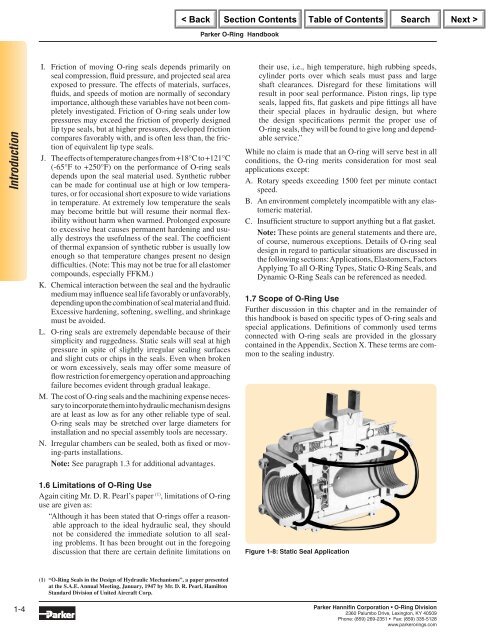Parker O-Ring Handbook.pdf
Parker O-Ring Handbook.pdf
Parker O-Ring Handbook.pdf
Create successful ePaper yourself
Turn your PDF publications into a flip-book with our unique Google optimized e-Paper software.
Introduction<br />
1-4<br />
I. Friction of moving O-ring seals depends primarily on<br />
seal compression, fl uid pressure, and projected seal area<br />
exposed to pressure. The effects of materials, surfaces,<br />
fl uids, and speeds of motion are normally of secondary<br />
importance, although these variables have not been completely<br />
investigated. Friction of O-ring seals under low<br />
pressures may exceed the friction of properly designed<br />
lip type seals, but at higher pressures, developed friction<br />
compares favorably with, and is often less than, the friction<br />
of equivalent lip type seals.<br />
J. The effects of temperature changes from +18°C to +121°C<br />
(-65°F to +250°F) on the performance of O-ring seals<br />
depends upon the seal material used. Synthetic rubber<br />
can be made for continual use at high or low temperatures,<br />
or for occasional short exposure to wide variations<br />
in temperature. At extremely low temperature the seals<br />
may become brittle but will resume their normal fl exibility<br />
without harm when warmed. Prolonged exposure<br />
to excessive heat causes permanent hardening and usually<br />
destroys the usefulness of the seal. The coeffi cient<br />
of thermal expansion of synthetic rubber is usually low<br />
enough so that temperature changes present no design<br />
diffi culties. (Note: This may not be true for all elastomer<br />
compounds, especially FFKM.)<br />
K. Chemical interaction between the seal and the hydraulic<br />
medium may infl uence seal life favorably or unfavorably,<br />
depending upon the combination of seal material and fl uid.<br />
Excessive hardening, softening, swelling, and shrinkage<br />
must be avoided.<br />
L. O-ring seals are extremely dependable because of their<br />
simplicity and ruggedness. Static seals will seal at high<br />
pressure in spite of slightly irregular sealing surfaces<br />
and slight cuts or chips in the seals. Even when broken<br />
or worn excessively, seals may offer some measure of<br />
fl ow restriction for emergency operation and approaching<br />
failure becomes evident through gradual leakage.<br />
M. The cost of O-ring seals and the machining expense necessary<br />
to incorporate them into hydraulic mechanism designs<br />
are at least as low as for any other reliable type of seal.<br />
O-ring seals may be stretched over large diameters for<br />
installation and no special assembly tools are necessary.<br />
N. Irregular chambers can be sealed, both as fi xed or moving-parts<br />
installations.<br />
Note: See paragraph 1.3 for additional advantages.<br />
1.6 Limitations of O-<strong>Ring</strong> Use<br />
Again citing Mr. D. R. Pearl’s paper (1) , limitations of O-ring<br />
use are given as:<br />
“Although it has been stated that O-rings offer a reasonable<br />
approach to the ideal hydraulic seal, they should<br />
not be considered the immediate solution to all sealing<br />
problems. It has been brought out in the foregoing<br />
discussion that there are certain defi nite limitations on<br />
(1) “O-<strong>Ring</strong> Seals in the Design of Hydraulic Mechanisms”, a paper presented<br />
at the S.A.E. Annual Meeting, January, 1947 by Mr. D. R. Pearl, Hamilton<br />
Standard Division of United Aircraft Corp.<br />
<strong>Parker</strong> O-<strong>Ring</strong> <strong>Handbook</strong><br />
their use, i.e., high temperature, high rubbing speeds,<br />
cylinder ports over which seals must pass and large<br />
shaft clearances. Disregard for these limitations will<br />
result in poor seal performance. Piston rings, lip type<br />
seals, lapped fi ts, fl at gaskets and pipe fi ttings all have<br />
their special places in hydraulic design, but where<br />
the design specifi cations permit the proper use of<br />
O-ring seals, they will be found to give long and dependable<br />
service.”<br />
While no claim is made that an O-ring will serve best in all<br />
conditions, the O-ring merits consideration for most seal<br />
applications except:<br />
A. Rotary speeds exceeding 1500 feet per minute contact<br />
speed.<br />
B. An environment completely incompatible with any elastomeric<br />
material.<br />
C. Insuffi cient structure to support anything but a fl at gasket.<br />
Note: These points are general statements and there are,<br />
of course, numerous exceptions. Details of O-ring seal<br />
design in regard to particular situations are discussed in<br />
the following sections: Applications, Elastomers, Factors<br />
Applying To all O-<strong>Ring</strong> Types, Static O-<strong>Ring</strong> Seals, and<br />
Dynamic O-<strong>Ring</strong> Seals can be referenced as needed.<br />
1.7 Scope of O-<strong>Ring</strong> Use<br />
Further discussion in this chapter and in the remainder of<br />
this handbook is based on specifi c types of O-ring seals and<br />
special applications. Defi nitions of commonly used terms<br />
connected with O-ring seals are provided in the glossary<br />
contained in the Appendix, Section X. These terms are common<br />
to the sealing industry.<br />
Figure 1-8: Static Seal Application<br />
<strong>Parker</strong> Hannifi n Corporation • O-<strong>Ring</strong> Division<br />
2360 Palumbo Drive, Lexington, KY 40509<br />
Phone: (859) 269-2351 Fax: (859) 335-5128<br />
www.parkerorings.com

















